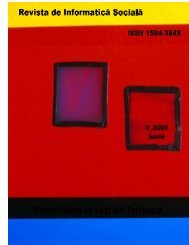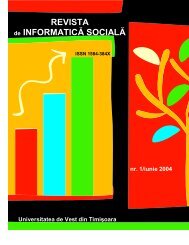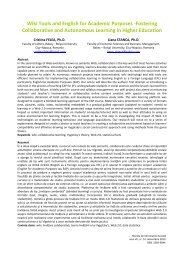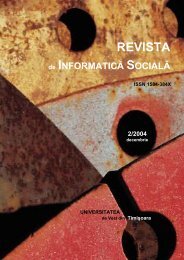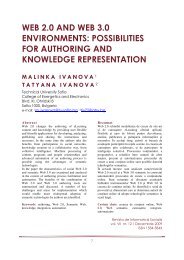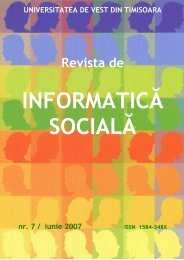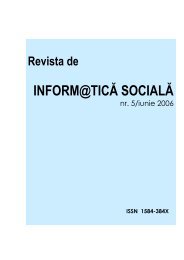No 13 - Journal of Social Informatics / Revista de Informatica Sociala
No 13 - Journal of Social Informatics / Revista de Informatica Sociala
No 13 - Journal of Social Informatics / Revista de Informatica Sociala
You also want an ePaper? Increase the reach of your titles
YUMPU automatically turns print PDFs into web optimized ePapers that Google loves.
conventional letters in <strong>de</strong>manding the drafting <strong>of</strong> a more complex piece <strong>of</strong> communication). This<br />
risk <strong>of</strong> getting involved into spirals <strong>of</strong> self-escalating conflicts makes Twitter unfit for discussion<br />
highly controversial (e. g. political) matters (Lynch 2008).<br />
On the other si<strong>de</strong>, however, Twitter invites people to articulate their bilateral conflicts in<br />
multilateral group settings: thus increasing the chance that mo<strong>de</strong>rating and mediating “third<br />
partners” will become active (Trombly 2008). While erroneous and emotionalized expressions are<br />
very likely to occur, this handicap may well be <strong>of</strong>fset at least partially by the rapidity with which<br />
responses are evoked that will counteract or correct such dysfunctional communications. Therefore,<br />
a genuine kind <strong>of</strong> “swarm intelligence” may be unleashed that is well compatible with rather hasty<br />
and irrational individual contributions.<br />
6. COORDINATED COLLECTIVE RESPONSES WITHOUT LEADERSHIP AND<br />
FORMAL ORGANIZATION<br />
It has been observed that one <strong>of</strong> the most significant innovation <strong>of</strong> the Internet is the fact<br />
that it has finished a two hundred year's evolution where only communication channels from oneto-many<br />
(mass media) and from one-to-one (Telephone) have been technologically <strong>de</strong>veloped,<br />
while one-to-many and especially many-to-many communications had still to rely on low-tech or<br />
even no-tech procedures (e. g. applause or mailed-our letters) (Geser 1996).<br />
Seen in this wi<strong>de</strong>r perspective, Twitter has an even greater capacity than other Internetrelated<br />
applications to support these two latter ways <strong>of</strong> communication, because it takes so little<br />
time and effort to compose as well as to read messages, so that an individual is easily capable <strong>of</strong><br />
following the postings <strong>of</strong> very many others – without being absorbed so much by reception that no<br />
time is left for sending answers.<br />
to one<br />
to many<br />
from one Telephone Mass media<br />
from many Internet / Twitter Internet / Twitter<br />
The “many-to-one” capacities are illustrated by Twitter press conferences where a large<br />
number <strong>of</strong> most peripheral lay participants can get a feeling <strong>of</strong> being actively involved: ins<strong>of</strong>ar as<br />
there is a chance that their Tweeted question gets read or even answered (Baratz 2009).<br />
The even more impressive “many-to-many” potentials can be realized in larger groups and<br />
organizations where Twitter may <strong>of</strong>fer the only – or at least the far most efficient way - to realize<br />
100% reciprocal connectivity even when the number <strong>of</strong> members is rather large: in the sense that<br />
every member regularly posts messages to all the others. Thus, Twitter can help larger collectivities<br />
to function similar to much smaller groupings: by maintaining <strong>de</strong>nsely knit webs <strong>of</strong> mutual<br />
cognizance and interaction. Therefore, even larger groupings get the potential to schedule very short<br />
term gatherings and micro-events ("tweetups"; Stamatiou et. al. 2008) and organize quick collective<br />
responses to ongoing events or <strong>de</strong>velopments (e. g. in the case <strong>of</strong> <strong>de</strong>monstrators who respond to<br />
police actions by immediate tactical moves).<br />
Within pre<strong>de</strong>fined collectivities (e. g. voluntary associations), multilateral short message<br />
tools are excellent in facilitating very quick opinion polls on current issues: by asking members to<br />
report not only yes or no answers to binary <strong>de</strong>cisions, but also more complex or<strong>de</strong>rs <strong>of</strong> preference or<br />
intensities <strong>of</strong> liking (e. g. on scales ranging from 0 to 10).<br />
pag. 12: <strong>Revista</strong> <strong>de</strong> Informatică <strong>Social</strong>ă | Vol. III (<strong>13</strong>) / 2010 | ISSN 1584-384X



